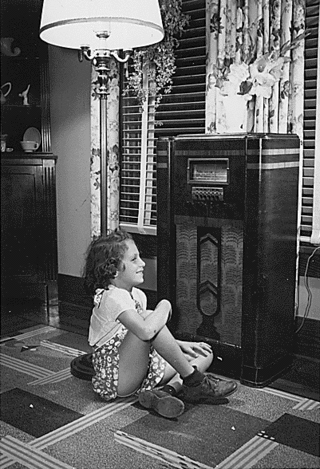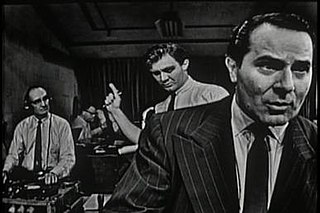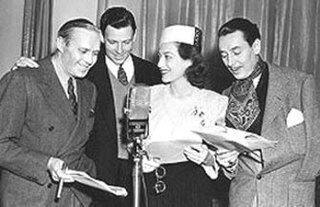Related Research Articles

The Golden Age of Radio, also known as the old-time radio (OTR) era, was an era of radio in the United States where it was the dominant electronic home entertainment medium. It began with the birth of commercial radio broadcasting in the early 1920s and lasted through the 1950s, when television gradually superseded radio as the medium of choice for scripted programming, variety and dramatic shows.
The year 1956 in television involved some significant events. Below is a list of television-related events during 1956.
The year 1955 in television involved some significant events. Below is a list of television-related events during 1955.
The year 1953 in television involved some significant events. Below is a list of television-related events during 1953.
The year 1952 in television involved some significant events. Below is a list of television-related events during 1952.

The Walt Disney Company has produced an anthology television series since 1954 under several titles and formats. The program's current title, The Wonderful World of Disney, was used from 1969 to 1979 and again from 1991 onward. The program moved among the Big Three television networks in its first four decades, but has aired on ABC since 1997 and Disney+ since 2020.
A television special is a standalone television show which may also temporarily interrupt episodic programming normally scheduled for a given time slot. Some specials provide a full range of entertainment and informational value available via the television medium, in various formats, and in any viewing lengths.

Hallmark Hall of Fame, originally called Hallmark Television Playhouse, is an anthology program on American television, sponsored by Hallmark Cards, a Kansas City–based greeting card company. It is the longest-running prime-time series in the history of television; it began airing in 1951 and is still currently in production. Since 1954, all of its productions have been broadcast in color. It was one of the first video productions to telecast in color, a rarity in the 1950s. Many television films have been shown on the program since its debut, though the program began with live telecasts of dramas and then changed to videotaped productions before finally changing to filmed ones.

The first Golden Age of Television is an era of television in the United States marked by its large number of live productions. The period is generally recognized as beginning in 1947 with the first episode of the drama anthology Kraft Television Theater and ending in 1960 with the final episode of Playhouse 90. The Golden Age was followed by the network era, wherein television audiences and programming had shifted to less critically acclaimed fare, almost all of it taped or filmed.

Lux Radio Theatre, sometimes spelled Lux Radio Theater, a classic radio anthology series, was broadcast on the NBC Blue Network (1934–35) ; CBS Radio network (1935–54), and NBC Radio (1954–55). Initially, the series adapted Broadway plays during its first two seasons before it began adapting films. These hour-long radio programs were performed live before studio audiences. The series became the most popular dramatic anthology series on radio, broadcast for more than 20 years and continued on television as the Lux Video Theatre through most of the 1950s. The primary sponsor of the show was Unilever through its Lux Soap brand.

An anthology series is a written series, radio, television, film, or video game series that presents a different story and a different set of characters in each different episode, season, segment, or short. These usually have a different cast in each episode, but several series in the past, such as Four Star Playhouse, employed a permanent troupe of character actors who would appear in a different drama each week. Some anthology series, such as Studio One, began on radio and then expanded to television.
Kraft Music Hall is an umbrella title for several television series aired by NBC in the United States from the 1950s to the 1970s in the musical variety genre, sponsored by Kraft Foods, the producers of a well-known line of cheeses and related dairy products. Their commercials were usually announced by "The Voice of Kraft", Ed Herlihy.

Ford Theatre, spelled Ford Theater for the original radio version and known, in full, as The Ford Television Theatre for the TV version, is a radio and television anthology series broadcast in the United States in the 1940s and 1950s. At various times the television series appeared on all three major television networks, while the radio version was broadcast on two separate networks and on two separate coasts. Ford Theatre was named for its sponsor, the Ford Motor Company, which had an earlier success with its concert music series, The Ford Sunday Evening Hour (1934–42).

The Screen Guild Theater is a radio anthology series broadcast from 1939 until 1952 during the Golden Age of Radio. Leading Hollywood stars performed adaptations of popular motion pictures. Originating on CBS Radio, it aired under several different titles including The Gulf Screen Guild Show, The Gulf Screen Guild Theater, The Lady Esther Screen Guild Theater and The Camel Screen Guild Players. Fees that would ordinarily have been paid to the stars and studios were instead donated to the Motion Picture Relief Fund, and were used for the construction and maintenance of the Motion Picture Country House.

Matinee Theater is an American anthology series that aired on NBC during the Golden Age of Television, from October 31, 1955, to June 27, 1958. Its name is often seen as Matinee Theatre.

Cameo Theatre is an American anthology series that aired on NBC during the Golden Age of Television, from 1950 to 1955, three times as a summer replacement and once as a mid-season replacement for other series.
NBC Saturday Night at the Movies was the first TV show to broadcast in color relatively recent feature films from major studios. The series premiered on September 23, 1961, and ran until October 1978, spawning many imitators. Previously, television stations had been only been able to show older, low-budget, black-and-white films that wouldn't be shown at movie theaters. In the late 1970s, competition from cable television and home video led to a decline in viewership.

For the television series of the same name, see The Silver Theatre.
ABC Mystery Theater, also known as just simply Mystery Theater or Mystery Theatre, was an American radio anthology, crime and mystery series from the 1950s. The program starred originally, actor Robert Carroll in the title role of Inspector Mark Saber, a British detective from the Homicide Squad then by actor Les Damon for seasons two and three. The program also centered on Saber's assistant Sgt. Tim Maloney, originally portrayed by character actor James Westerfield for the first half of season one, actor Douglas Chandler for the second half of season one and finally by character actor Walter Burke for seasons two and three.
References
- 1 2 3 The Complete Directory to Prime Time Network and Cable TV Shows 1946-Present . Ballantine Books. 2003. p. 1178. ISBN 0-345-45542-8.